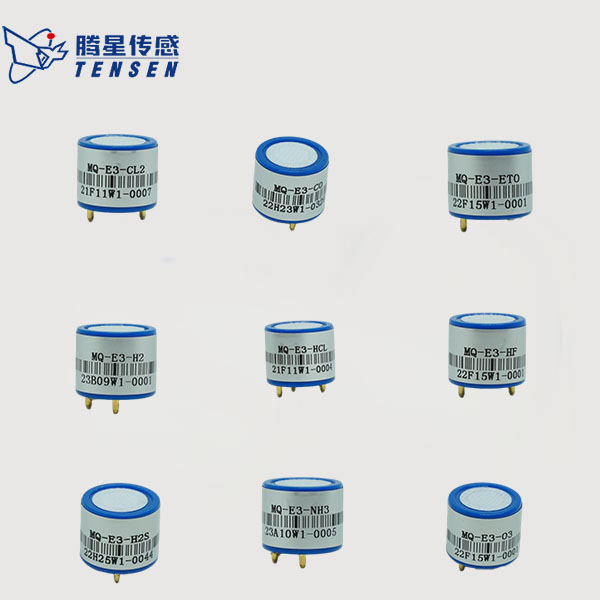

 News
News Industry News
Industry News The development of electrochemical gas sensors is a history of moving from laboratory prototypes to industrial and civilian applications, and from single oxygen monitoring to the precise detection of multiple toxic gases. Generally speaking, the development history of electrochemical gas sensors can be divided into the following stages:
19th Century: Foundation of Electrochemical Principles
• In 1833–1834, Faraday's law of electrolysis provided a quantitative basis for the proportional current generated by the gain and loss of electrons in a gas at an electrode.
• In 1889, the Nernst equation established a calculable mathematical relationship between electrode potential and gas partial pressure, becoming the common theoretical foundation for later potentiometric and current-type sensors.
1950s: Birth of Dedicated Oxygen Sensors
• In 1953–1956, Clark et al. combined a permeable membrane, electrolyte, and noble metal electrode to form a membrane-covered oxygen electrode for measuring dissolved oxygen in blood, considered the first practical electrochemical gas sensor.
• During the same period, Bergman and Niedrach developed an amperometric oxygen sensor for NASA's spacecraft, introducing a three-electrode system (working electrode/counter electrode/reference electrode) for gas detection for the first time, laying the foundation for the basic architecture of modern electrochemical sensors.
1960s–70s: The Emergence of Toxic Gas Detection
• After discovering the insufficient selectivity of semiconductor sensors (TGS, also known as the Taguchi gas detector, invented by the Japanese Taguchi in 1962) for gases such as CO and H₂S, European scientists began to shift their focus to electrochemical sensors (EGS, electrochemical gas sensors).
• Between 1967 and 1975, Neotronics of the UK and Mine Safety Appliances (MSA) of the US successively obtained several patents for CO, NO, and SO₂ sensors based on platinum black-PTFE gas diffusion electrodes, enabling EGS to move out of the laboratory and into the fields of mine and factory safety.
1980s: Miniaturization and Multi-component Detection
• Between 1984 and 1986, with the maturity of microfabrication technology and low-power potentiostats, "button-type" three-electrode sensors with a diameter <20 mm and a thickness <10 mm were introduced, which could be directly installed in portable alarm devices.
• In 1987, CityTech (later acquired by Honeywell) in the UK launched its 4-series CO/H₂S/NO/SO₂ sensors, achieving sensitivity in the 1 ppm range and a lifespan exceeding 24 months, marking a new stage in the commercialization of EGS.
1990s: Exploration of Solid-State and Hybrid Electrolytes
• To overcome problems such as leakage and evaporation of liquid electrolytes, two major technical routes emerged in the 1990s: "all-solid-state polymer electrolytes (SPE)" and "room-temperature ionic liquids."
• In 1995, Dräger in Germany released the first SPE oxygen sensor, with an operating temperature range of −40 ℃–+60 ℃, successfully used in submarines and high-altitude vehicles.
Early 21st Century: MEMS and Low Power Consumption
• 2003–2006: General Electric (USA) and Alphasense (UK) collaborated to launch a MEMS microcavity three-electrode CO sensor, reducing its size to 8 mm × 8 mm × 3 mm and its average power consumption to <100 μW, allowing it to be powered directly by a coin cell battery for more than 5 years.
• 2007: CityTech (UK) launched the MNOLO sensor for detecting exhaled NO, achieving a resolution at the ppb level. In 2022, CityTech further launched ppb-level electrochemical sensors for environmental monitoring, such as SO2, pushing the detection limit of traditional EGS by an order of magnitude.
2010s to Present: Intelligentization and Arraying
• Since 2015, companies such as Sensirion (Switzerland) and AMS (Netherlands) have integrated temperature/humidity/pressure sensors with EGS through system-level packaging, and integrated MCUs for temperature drift compensation and cross-interference correction, achieving "digital interface + self-calibration". • Since 2020, deep learning-based gas identification algorithms combined with EGS arrays can simultaneously output the concentrations of five gases—CO, NO₂, SO₂, O₃, and NH₃—within a 1 cm³ volume, with an error of <±5% FS. These technologies have been applied in urban air quality monitoring stations, wearable health monitoring, and smart homes.

After more than 70 years of development, the electrochemical sensor industry is highly mature. However, with the emergence of new technologies, the integration of electrochemical sensors with IoT and AI technologies continues to generate even broader application possibilities.